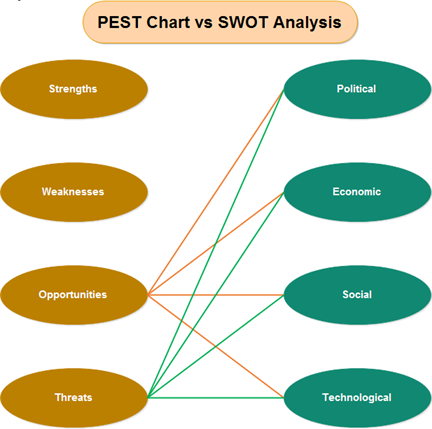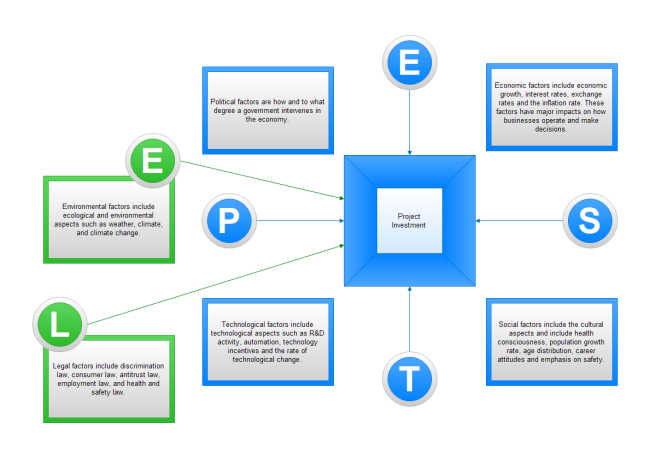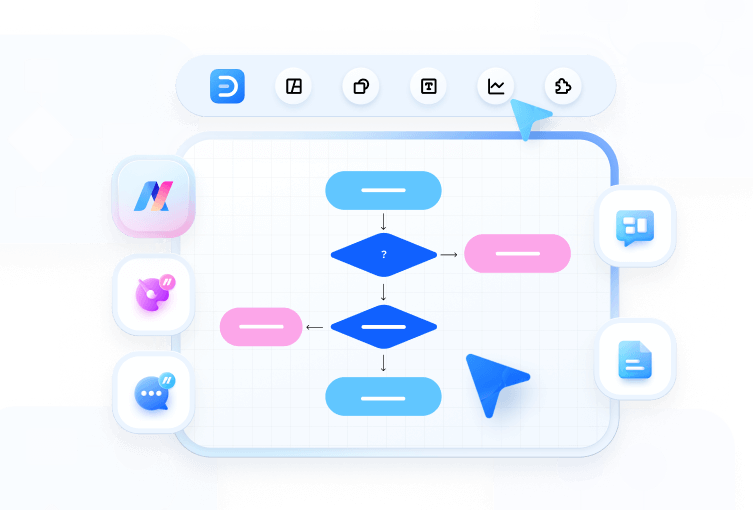PEST Chart and SWOT Analysis
There is some overlap between PEST and SWOT, however; PEST and SWOT are certainly two different perspectives. PEST tends to assess a market, including competitors, from the standpoint of a particular proposition or a business. SWOT in business and marketing tends to be an assessment of a business or a proposition, whether it is your own business or (less commonly) a competitor's business or proposition.

What is a PEST Chart?
PEST chart is a short form for "Political, Economic, Social and Technological analysis chart" and it describes a frame work of macro-environmental factors used in the environmental strategies. PEST analysis would be able to complement the SWOT analysis in a strategic planning process.

Four factors for the PEST chart are:
Political - Laws, global issues, legislation and regulations which may have an effect on your business either immediately or in the future.
Economic - Taxes, interest rates, inflation, the stock markets and consumer confidence all need to be taken into account.
Social - The changes in lifestyle and buying trends, media, major events, ethics, advertising and publicity factors.
Technological - Innovations, access to technology, licensing and patents, manufacturing, research funding, global communications.
PEST can also be known as PESTLE which includes other two factors such as:
Legal - Legislation which have been proposed and may come into effect and any passed legislation's.
Environmental - Environmental issues either locally or globally and their social and political factors.
Advantages and Disadvantages of PEST Chart
PEST chart is simple and easy to make. It provides an understanding of the wider business environment and encourages the development of strategic thinking. Moreover, it helps people to raise awareness of threats to a project. It help an organization to anticipate future difficulties and take action to avoid or minimize their effect. Meanwhile, it helps an organization to spot opportunities and exploit them.
The external factors of PEST chart are looked at closely but there are no internal evaluations carried out. It costs a little bit longer to draw a PEST chart. PEST analysis only covers the external environment and the results need to be considered with other factors, such as the organization itself, competitors and the industry in which it is working. At the same time, PEST chart collects large amounts of information may make it difficult to see the wood for the trees and lead to "paralysis by analysis."
What is SWOT Analysis?
The SWOT analysis is an extremely useful tool for understanding and decision-making for all sorts of situations in business and organizations. SWOT is an acronym for Strengths, Weaknesses, Opportunities, Threats. To get the most complete, objective results, a SWOT analysis is best conducted by a group of people with different perspectives and stakes in one company, like management, sales, customer service, and even customers can all contribute valid insight.

Moreover, the SWOT analysis process is an opportunity to bring your team together and encourage their participation in and adherence to your company's resulting strategy. The point of a SWOT analysis is to help you develop a strong business strategy by making sure you've considered all of your business's strengths and weaknesses, as well as the opportunities and threats it faces in the marketplace.
Advantages and Disadvantages of SWOT Analysis
SWOT analysis can be applied to an organization, organizational unit, individual or team. In addition, the analysis can support a number of project objectives. For example, the SWOT method can be used to evaluate a product or brand, an acquisition or partnership, or the outsourcing of a business function. In addition, SWOT analysis can be beneficial in evaluating a particular supply source, a business process, a product market or the implementation of a particular technology.
Although SWOT analysis is simple to come up with a list but far too easy to miss important external factors. SWOT analysis leads to four individual factors but provides no mechanism to rank the significance of one factor versus another within any list. As a result, any factor's true impact on the objective can't be determined. SWOT data collection and analysis entail a subjective process that reflects the bias of the individuals who collect the data and participate in the brainstorming session. In addition, the data input to the SWOT analysis can become outdated fairly quickly.
Conclusion
Due to the advantages and the disadvantages of using either one or the other methods it is a good idea to combine the two to help provide you with the best analysis. It is good practice to perform the PEST and then use the results in the opportunities and threat section of the SWOT.
Learn how to conduct PEST analysis and how to do SWOT analysis.





